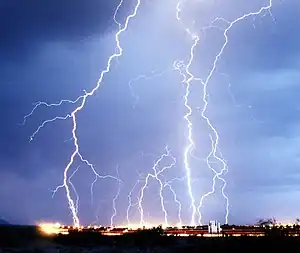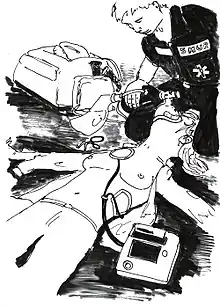Lightning injury
| Lightning injury | |
|---|---|
| Other names: Effects of lightning | |
 | |
| Multiple lightning bolts strike a populated area. | |
| Specialty | Emergency medicine |
| Usual onset | 20 to 45 year old males[1] |
| Types | Direct strikes, side splash, contact injury, ground current[1] |
| Causes | Lightning strike[1] |
| Diagnostic method | Based on history of the injury and examination[1] |
| Prevention | Avoiding the outdoors during a thunderstorm[2] |
| Treatment | CPR, artificial ventilation[1] |
| Frequency | 240,000 a year[1] |
| Deaths | 24,000 a year[1] |
Lightning injuries are injuries caused by a lightning strike.[3] Initial symptoms may include heart asystole and respiratory arrest.[1] While the asystole may resolve spontaneously fairly rapidly, the respiratory arrest is typically more prolonged.[1] Other symptoms may include burns and blunt injuries.[1] Of those who survive about 75% have ongoing health problems as a result, such as cataracts and hearing loss.[1] If death occurs it is typically from either an abnormal heart rhythm or respiratory failure.[1]
Lighting injuries are divided into direct strikes, side splash, contact injury, and ground current.[1] Ground current make up about half of cases and occurs when the lightning strikes nearby and travels to the person through the ground.[1] Side splash makes up about a third of cases and occurs when lightning strikes nearby and jumps through the air to the person.[1] Contact injury occurs when the person is touching the object that is hit.[1] Direct strikes make up about 5% of injuries.[1] The mechanism of the injuries may include electrical injury, burns from heat, and mechanical trauma.[1] Diagnosis is typically based on history of the injury and examination.[1]
Prevention includes avoiding being outdoors during a thunderstorm.[2] If avoiding being outdoors is unavoidable crouching low is recommended.[2] When indoors the use of devices connected to electrical outlets and contact with water is not recommended.[2] Among those who appear in cardiac arrest and have no central pulse, cardiopulmonary resuscitation (CPR) should be started.[1] In those who have a central pulse but are not breathing artificial ventilation, such as mouth to mouth, is recommended.[1][4]
It is estimated that lightning injuries occur 240,000 times a year with 24,000 deaths.[1] Areas with mountainous terrain and moisture-heavy airflow, such as Central Africa, have the highest rates of lightning strikes.[5] Among pregnant women who are hit by lightning, the death of the baby occurs in about half.[1] In the United States about 1 in 10,000 people is hit by lightning during their lifetime.[1] Males are affected 4 times more often than females.[1] The age group most commonly affected is 20 to 45 years old.[1]
Signs and symptoms

Common injuries caused by lightning include: muscle pains, broken bones, cardiac arrest, confusion, hearing loss, seizures, burns, behavioral changes, and ocular cataracts.[3][6] Loss of consciousness is very common immediately after a strike.[7]
Lighting burns result from energy caused by lightning strikes, and are characterized by a unique pattern of skin lesions. These tree-like lesions resemble feathering or ferning, and are also called “Lichtenberg figures".[8] The marks are formed when capillaries beneath the skin rupture due to the electrical discharge and they usually appear "within hours" of the strike though they tend to disappear within a few days. They also generally occur on the upper body.[9] The brief duration of the exposure frequently limits the damage to the outer layer of skin.[10]
The intense heat generated by a lightning strike can burn tissue, and cause lung damage, and the chest can be damaged by the mechanical force of rapidly expanding heated air.[3]
Just as heat can cause expanding air in the lungs, the explosive shock wave created by lightning (the cause of thunder) can cause concussive and hearing damage at extremely close range. Other physical injury can be caused by objects damaged or thrown by the lightning strike. For example, lightning striking a nearby tree may vaporize sap, and the steam explosion often causes bark and wood fragments to be explosively ejected.
Lightning strikes can also induce a transient paralysis known as keraunoparalysis.[6] Signs and symptoms of keraunoparalysis include lack of pulse, pallor or cyanosis, and motor and sensory loss in the extremities. However, keraunoparalysis usually resolves within a few hours.[6]
Pathophysiology
Although the current flow of a lightning strike occurs only over a short period, the current has an extremely high voltage of some 30 million volts.[11] Lightning is neither a DC or an AC current but best described as a unidirectional massive current impulse of electrons.[11]
Lightning strikes are grouped in four categories: direct strikes, side splash, contact injury, and ground current.[1]
- Direct strike: lightning directly hits the person
- Orifice entry: may occur if lightning strike occurs near the head entering eyes, ears and mouth to flow internally
- Side splash: lightning jumps from the location of primary strike to a nearby person
- Contact injury: injury that occurs when a person is touching an object on the pathway of lightning
- Ground current: lightning strikes nearby and the current travels through the ground to the person
Lightning injury may occur by these electrical mechanisms or by secondary blunt trauma as a result of the strike.[12]
Diagnosis
Diagnosis is typically based on history of the injury and examination.[1]
Prevention
Preventing lightning injury involves avoiding being outdoors during a thunderstorm.[2][13] While no place is entirely safe from lightning strikes, seeking a substantial shelter or an enclosed all-metal car is recommended.[13][14][15] If being outdoors is unavoidable, staying away from metal objects, tall structures, and open, exposed areas is strongly suggested.[13][14] When there is risk of imminent lightning strike, crouching low with one's knees and feet together can be used, however this is typically used as a last resort since this position can be difficult to maintain for an extended period of time.[2][13][14] For large groups of people, it is recommended that individuals spread out to avoid mass casualties.[13][15] When indoors, the use of devices connected to electrical outlets and contact with water is not recommended.[2]
Treatment
Immediate

The most critical injuries are cardiac arrest and respiratory failure. This will often require prompt emergency care.[7] It is safe to provide care immediately, as the affected person will not retain an electrical charge after the lightning has struck.[4]
Many people who are unconscious and appear lifeless die of suffocation.[14] Chances of survival may be increased if cardiopulmonary resuscitation (CPR) is started immediately, and continued without interruption until the brainstem recovers.[16]
Long-term
A complete physical examination by paramedics or physicians may reveal ruptured eardrums. Ocular cataracts may later develop, sometimes more than a year after an otherwise uneventful recovery. Long-term injuries are usually neurological in nature, including memory deficit, sleep disturbance, chronic pain, and chronic dizziness.[17]
Prognosis
The mortality rate for lightning strike is approximately 10%.[1] Survivors of lightning strike may suffer long term injury or disability.[18]
Epidemiology
It is estimated that lightning injuries occur 240,000 times a year with 24,000 deaths.[1] Among pregnant women who are hit by lightning, the death of the baby occurs in about half.[1] In the United States about 1 in 10,000 people is hit by lightning during their lifetime.[1] Males are affected 4 times more often than females.[1] The age group most commonly affected is 20 to 45 years old.[1]
References
- 1 2 3 4 5 6 7 8 9 10 11 12 13 14 15 16 17 18 19 20 21 22 23 24 25 26 27 28 29 30 31 32 33 34 Jensen, JD; Vincent, AL (January 2019). "Lightning Injuries". StatPearls. PMID 28722949.
- 1 2 3 4 5 6 7 "Lightning Safety Tips". CDC. 23 January 2019. Archived from the original on 7 November 2019. Retrieved 11 November 2019.
- 1 2 3 Mallinson, T (2013). "Understanding the correct assessment and management of lightning injuries". Journal of Paramedic Practice. 5 (4): 196–201. doi:10.12968/jpar.2013.5.4.196.
- 1 2 "First Aid Recommendations Lightning". CDC. 23 January 2019. Archived from the original on 21 October 2019. Retrieved 11 November 2019.
- ↑ Davis, Chris; Engeln, Anna; Johnson, Eric L.; McIntosh, Scott E.; Zafren, Ken; Islas, Arthur A.; McStay, Christopher; Smith, William R.; Cushing, Tracy; Wilderness Medical Society (December 2014). "Wilderness Medical Society practice guidelines for the prevention and treatment of lightning injuries: 2014 update". Wilderness & Environmental Medicine. 25 (4 Suppl): S86–95. doi:10.1016/j.wem.2014.08.011. ISSN 1545-1534. PMID 25498265.
- 1 2 3 Davis, Chris; Engeln, Anna; Johnson, Eric L.; McIntosh, Scott E.; Zafren, Ken; Islas, Arthur A.; McStay, Christopher; Smith, William R.; Cushing, Tracy (December 2014). "Wilderness Medical Society Practice Guidelines for the Prevention and Treatment of Lightning Injuries: 2014 Update". Wilderness & Environmental Medicine. 25 (4): S86–S95. doi:10.1016/j.wem.2014.08.011. ISSN 1080-6032. PMID 25498265.
- 1 2 Mallinson, T (2010). "Lightning Injuries". Focus on First Aid (16): 15–16. Archived from the original on 11 March 2012. Retrieved 2010-09-30.
- ↑ "DynaMed". www.dynamed.com. Archived from the original on 2021-05-16. Retrieved 2019-11-25.
- ↑ "How do you recover from being struck by lightning?". Archived from the original on 9 August 2013. Retrieved 9 August 2013.
- ↑ "Lightning Injuries - Injuries and Poisoning". Merck Manuals Consumer Version. Archived from the original on 2020-02-26. Retrieved 2019-11-25.
- 1 2 Auerbach, Paul S. (2011). Advanced wilderness life support : prevention, diagnosis, treatment, evacuation (7th ed.). Utah: Wilderness Medicine Society. ISBN 978-0-615-49608-5. OCLC 829392080.
- ↑ O’Keefe, K. P.; Semmons, R. (2018). Electrical and Lightning Injuries in Rosen's emergency medicine: concepts and clinical practice (9th). St. Louis, Missouri: Mosby. pp. 1765–1772.
- 1 2 3 4 5 Davis, Chris; Engeln, Anna; Johnson, Eric L.; McIntosh, Scott E.; Zafren, Ken; Islas, Arthur A.; McStay, Christopher; Smith, William R.; Cushing, Tracy; Wilderness Medical Society (December 2014). "Wilderness Medical Society practice guidelines for the prevention and treatment of lightning injuries: 2014 update". Wilderness & Environmental Medicine. 25 (4 Suppl): S86–95. doi:10.1016/j.wem.2014.08.011. ISSN 1545-1534. PMID 25498265.
- 1 2 3 4 Ritenour, Amber E.; Morton, Melinda J.; McManus, John G.; Barillo, David J.; Cancio, Leopoldo C. (August 2008). "Lightning injury: a review". Burns: Journal of the International Society for Burn Injuries. 34 (5): 585–594. doi:10.1016/j.burns.2007.11.006. ISSN 0305-4179. PMID 18395987.
- 1 2 Auerbach, Paul S. (May 1992). "Wilderness medicine epidemiology". Journal of Wilderness Medicine. 3 (2): 111–112. doi:10.1580/0953-9859-3.2.111. ISSN 0953-9859.
- ↑ Dayton, L (1993). "Science: Secrets of a bolt from the blue" Archived 2015-01-08 at the Wayback Machine, New Scientist, 18 December 1993.
- ↑ NOAA Lightning Safety Facts
- ↑ Sanford, Arthur; Gamelli, Richard L. (2014), "Lightning and thermal injuries", Handbook of Clinical Neurology, Elsevier, 120: 981–986, doi:10.1016/b978-0-7020-4087-0.00065-6, ISBN 978-0-7020-4087-0, PMID 24365365
External links
| Classification |
|---|